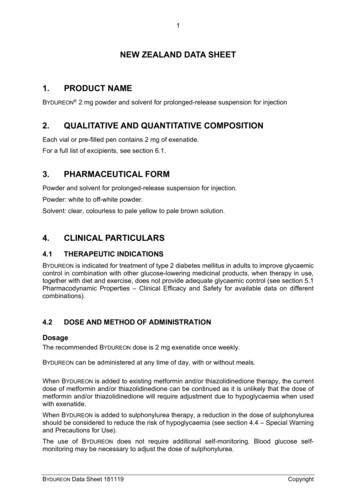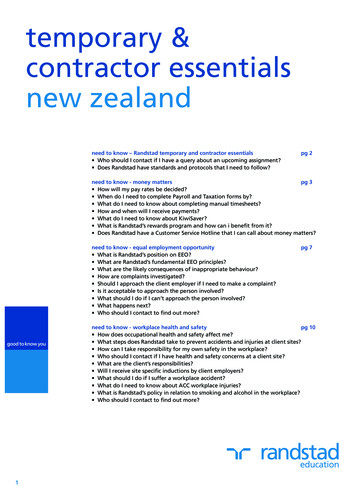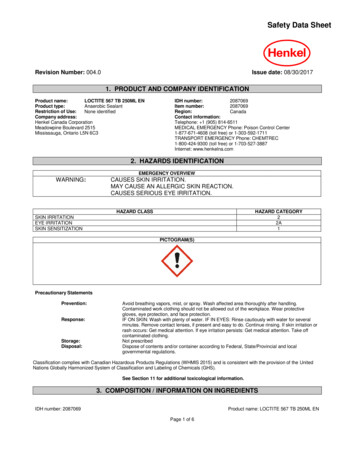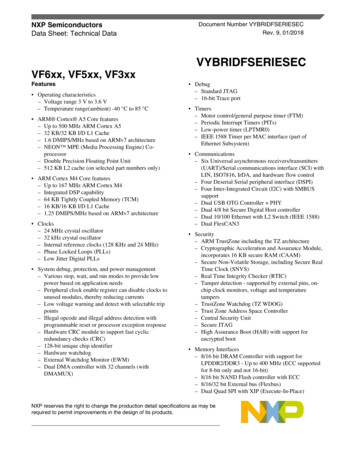
Transcription
1NEW ZEALAND DATA SHEET1.PRODUCT NAMEBYDUREON 2 mg powder and solvent for prolonged-release suspension for injection2.QUALITATIVE AND QUANTITATIVE COMPOSITIONEach vial or pre-filled pen contains 2 mg of exenatide.For a full list of excipients, see section 6.1.3.PHARMACEUTICAL FORMPowder and solvent for prolonged-release suspension for injection.Powder: white to off-white powder.Solvent: clear, colourless to pale yellow to pale brown solution.4.CLINICAL PARTICULARS4.1THERAPEUTIC INDICATIONSBYDUREON is indicated for treatment of type 2 diabetes mellitus in adults to improve glycaemiccontrol in combination with other glucose-lowering medicinal products, when therapy in use,together with diet and exercise, does not provide adequate glycaemic control (see section 5.1Pharmacodynamic Properties – Clinical Efficacy and Safety for available data on differentcombinations).4.2DOSE AND METHOD OF ADMINISTRATIONDosageThe recommended BYDUREON dose is 2 mg exenatide once weekly.BYDUREON can be administered at any time of day, with or without meals.When BYDUREON is added to existing metformin and/or thiazolidinedione therapy, the currentdose of metformin and/or thiazolidinedione can be continued as it is unlikely that the dose ofmetformin and/or thiazolidinedione will require adjustment due to hypoglycaemia when usedwith exenatide.When BYDUREON is added to sulphonylurea therapy, a reduction in the dose of sulphonylureashould be considered to reduce the risk of hypoglycaemia (see section 4.4 – Special Warningand Precautions for Use).The use of BYDUREON does not require additional self-monitoring. Blood glucose selfmonitoring may be necessary to adjust the dose of sulphonylurea.BYDUREON Data Sheet 181119Copyright
2Changing Weekly Dosing ScheduleThe day of weekly administration can be changed if necessary as long as the last dose wasadministered 3 or more days before.Missed DoseIf a dose is missed, it should be administered as soon as noticed, provided the next regularlyscheduled dose is due at least 3 days later. Thereafter, patients can resume their usual dosingschedule of once every 7 days (weekly).Switching from BYETTA to BYDUREONPatients switching from exenatide twice daily (BYETTA) to BYDUREON may experience transientelevations in blood glucose concentrations, which generally improve within the first two weeksafter initiation of therapy.DiscontinuationIf a different antidiabetic treatment is started after the discontinuation of BYDUREON,consideration should be given to the prolonged release of BYDUREON (see section 5.2 –Pharmacokinetic Properties).Special populationsElderlyNo dose adjustment is required based on age. However, as renal function generally declineswith age, consideration should be given to the patient’s renal function (see patients with renalimpairment). The clinical experience in patients 75 years is very limited (see section 5.2 Pharmacokinetic Properties).Patients with renal impairmentNo dose adjustment is necessary for patients with mild or moderate renal impairment(creatinine clearance 30 to 80 mL/min) (see section 5.2 - Pharmacokinetic Properties).BYDUREON is not recommended for use in patients with end-stage renal disease or severerenal impairment (creatinine clearance 30 mL/min) (see section 4.4 – Special Warnings andPrecautions for Use).Patients with hepatic impairmentNo dose adjustment is necessary for patients with hepatic impairment (see section 5.2 Pharmacokinetic Properties).Paediatric populationThe safety and efficacy of BYDUREON in children and adolescents aged under 18 years havenot yet been established (see section 5.2 -Pharmacokinetic Properties).Method of administrationBYDUREON is for self-administration by the patient. Each kit or pen should be used by oneperson only and is for single use.BYDUREON is administered as a subcutaneous injection and must not be administeredintravenously or intramuscularly.When used in combination with insulin, BYDUREON and insulin must be administered as twoseparate injections. It is acceptable to inject BYDUREON and insulin in the same region of thebody, but the injections should not be adjacent to each otherBYDUREON Data Sheet 181119Copyright
3Appropriate training is recommended for non-healthcare professionals administering theproduct. The “Instructions for the User”, provided in the carton, must be followed carefully bythe patient.Each dose should be administered in the abdomen, thigh, or the back of the upper arm as asubcutaneous injection immediately after suspension of the powder in the solvent.For instructions on the suspension of the medicinal product before administration, see section6.6 Special Precautions for Disposal and Other Handling and the “Instructions for the User”.4.3CONTRAINDICATIONSHypersensitivity to the active substance or to any of the excipients.BYDUREON should not be used in patients with end-stage renal disease or severe renalimpairment (creatinine clearance 30 mL/min). Compared with healthy subjects, renalclearance of exenatide was significantly reduced in patients with end-stage renal diseasereceiving dialysis, resulting in poor gastrointestinal tolerability.4.4SPECIAL WARNINGS AND PRECAUTIONS FOR USEGeneralBYDUREON should not be used in patients with type 1 diabetes mellitus or for the treatment ofdiabetic ketoacidosis.BYDUREON must not be administered by intravenous or intramuscular injection.This medicine contains less than 1 mmol sodium (23 mg) per dose, i.e. essentially “sodiumfree”.Renal impairmentIn patients with end-stage renal disease receiving dialysis, single doses of exenatide twicedaily increased frequency and severity of gastrointestinal adverse reactions thereforeBYDUREON is not recommended for use in patients with end-stage renal disease or severerenal impairment (creatinine clearance 30 ml/min) – see section 4.3 - Contraindications.Altered Renal FunctionThere have been rare, spontaneously reported events of altered renal function with exenatide,including increased serum creatinine, renal impairment, worsened chronic renal failure andacute renal failure, sometimes requiring haemodialysis. Some of these events occurred inpatients experiencing events that may affect hydration, including nausea, vomiting, and/ordiarrhoea and/or receiving medicinal products known to affect renal function/hydration status.Concomitant medicinal products included angiotensin converting enzymes inhibitors,angiotensin-II antagonists, non-steroidal anti-inflammatory medicinal products and diuretics.Reversibility of altered renal function has been observed with supportive treatment anddiscontinuation of potentially causative agents, including exenatide.Severe gastrointestinal diseaseBYDUREON has not been studied in patients with severe gastrointestinal disease, includinggastroparesis. Its use is commonly associated with gastrointestinal adverse reactions,including nausea, vomiting, and diarrhoea. Therefore, the use of BYDUREON is notrecommended in patients with severe gastrointestinal disease.BYDUREON Data Sheet 181119Copyright
4Acute pancreatitisThere have been spontaneously reported events of acute pancreatitis. Patients should beinformed of the characteristic symptom of acute pancreatitis: persistent, severe abdominalpain. Resolution of pancreatitis has been observed with supportive treatment, but very rarecases of necrotizing or haemorrhagic pancreatitis and/or death have been reported. Ifpancreatitis is suspected, BYDUREON and other potentially suspect medicinal products shouldbe discontinued. Treatment with BYDUREON should not be resumed after pancreatitis has beendiagnosed.Concomitant medicinal productsThe concurrent use of BYDUREON with prandial insulin, D-phenylalanine derivatives(meglitinides), alpha-glucosidase inhibitors, dipeptidyl peptidase-4 inhibitors or other GLP-1receptor agonists has not been studied. The concurrent use of BYDUREON and other GLP-1receptor agonists is not recommended.HypoglycaemiaThe risk of hypoglycaemia was increased when BYDUREON was used in combination with asulphonylurea in clinical trials. Furthermore, in the clinical studies, patients on a sulphonylureacombination, with mild renal impairment had an increased incidence of hypoglycaemiacompared to patients with normal renal function. To reduce the risk of hypoglycaemiaassociated with the use of a sulphonylurea, reduction in the dose of sulphonylurea should beconsidered.Rapid weight lossRapid weight loss at a rate of 1.5 kg per week has been reported in patients treated withexenatide. Weight loss of this rate may have harmful consequences.Interaction with warfarinSince market introduction, there have been some spontaneously reported cases of increasedINR (International Normalized Ratio), sometimes associated with bleeding, with concomitantuse of warfarin and exenatide (see section 4.5 – Interactions and 4.8 – Undesirable Effects).Discontinuation of treatmentAfter discontinuation, the effect of BYDUREON may continue as plasma levels of exenatidedecline over 10 weeks. Choice of other medicinal products and dose selection should beconsidered accordingly, as adverse reactions may continue and efficacy may, at least partly,persist until exenatide levels decline.4.5INTERACTION WITH OTHER MEDICINES AND OTHER FORMS OFINTERACTIONEffects of other medicinal products on BYDUREONThe results of a study using paracetamol as a marker of gastric emptying suggest that theeffect of BYDUREON to slow gastric emptying is minor and not expected to cause clinicallysignificant reductions in the rate and extent of absorption of concomitantly administered oralmedicinal products. Therefore, no dose adjustments for medicinal products sensitive todelayed gastric emptying are required.When 1,000 mg paracetamol tablets were administered, either with or without a meal, following14 weeks of BYDUREON therapy, no significant changes in paracetamol AUC were observedcompared to the control period. Paracetamol Cmax decreased by 16 % (fasting) and 5 % (fed)BYDUREON Data Sheet 181119Copyright
5and tmax was increased from approximately 1 hour in the control period to 1.4 hours (fasting)and 1.3 hours (fed).SulphonylureasThe dose of a sulphonylurea may require adjustment due to the increased risk ofhypoglycaemia associated with sulphonylurea therapy (see sections 4.2 – Dose and Methodof Administration and 4.4 – Special Warnings and Precautions for Use).The following interaction studies have been conducted using 10 mcg exenatide twice daily butnot exenatide once weekly.Interaction studies with exenatide have only been performed in adults.Hydroxy Methyl Glutaryl Coenzyme A reductase inhibitorsLovastatin AUC and Cmax were decreased approximately 40 % and 28 %, respectively, andtmax was delayed about 4 h when exenatide twice daily was administered concomitantly with asingle dose of lovastatin (40 mg) compared with lovastatin administered alone. In exenatidetwice daily 30-week placebo-controlled clinical trials, concomitant use of exenatide and HMGCoA reductase inhibitors was not associated with consistent changes in lipid profiles (seesection 5.1 – Pharmacodynamic Properties). No predetermined dose adjustment is required;however lipid profiles should be monitored as appropriate.WarfarinA delay in tmax of about 2 h was observed when warfarin was administered 35 min afterexenatide twice daily. No clinically relevant effects on Cmax or AUC were observed. IncreasedINR has been reported during concomitant use of warfarin and exenatide once weekly. INRshould be monitored during initiation of BYDUREON therapy in patients on warfarin and/orcumarol derivatives (see sections 4.4 – Special Warnings and Precautions for Use and 4.8 –Undesirable Effects).Digoxin and lisinoprilIn interaction studies of the effect of exenatide twice daily on digoxin and lisinopril there wereno clinical relevant effects on Cmax or AUC, however a delay in tmax of about 2 h was observed.Ethinyl estradiol and levonorgestrelAdministration of a combination oral contraceptive (30 mcg ethinyl estradiol plus 150 mcglevonorgestrel) one hour before exenatide twice daily did not alter the AUC, Cmax or Cmin ofeither ethinyl estradiol or levonorgestrel. Administration of the oral contraceptive 35 minutesafter exenatide did not affect AUC but resulted in a reduction of the Cmax of ethinyl estradiol by45 %, and Cmax of levonorgestrel by 27-41 %, and a delay in tmax by 2-4 h due to delayed gastricemptying. The reduction in Cmax is of limited clinical relevance and no adjustment of dosing oforal contraceptives is required.4.6FERTILITY, PREGNANCY AND LACTATIONWomen of childbearing potentialDue to the long washout period of BYDUREON, women of childbearing potential should usecontraception during treatment with BYDUREON. BYDUREON should be discontinued at least 3months before a planned pregnancy.BYDUREON Data Sheet 181119Copyright
6PregnancyExenatide is not recommended for use during pregnancy. No specific studies have beenconducted in pregnant women. Data on a limited number of exposed pregnancies indicate noadverse effects of exenatide on pregnancy or on the health of the foetus/new born child.BreastfeedingIt is unknown whether exenatide is excreted in human milk. In lactating mice given high dosesof exenatide, low concentrations of exenatide were detected in milk. Exenatide should beadministered to nursing women only if the potential benefit to the mother justifies the potentialrisk to the infant.FertilityNo fertility studies in humans have been conducted.4.7EFFECTS ON ABILITY TO DRIVE AND USE MACHINESNo studies on the effects of the ability to drive and use machines have been performed. WhenBYDUREON is used in combination with a sulphonylurea or insulin, patients should be advisedto take precautions to avoid hypoglycaemia while driving and using machines.4.8UNDESIRABLE EFFECTSSummary of the safety profileThe most frequent adverse drug reactions ( 5 % of BYDUREON treatment) weregastrointestinal related (nausea, vomiting, diarrhoea and constipation). The most frequentlyreported adverse reaction was nausea which was associated with the initiation of treatmentand decreased over time. In addition, injection site reactions (pruritus, nodules, erythema),hypoglycaemia (with a sulphonylurea), and headache occurred. Most adverse reactionsassociated with BYDUREON were mild to moderate in intensity.Tabulated summary of adverse reactionsThe frequency of adverse reactions of BYDUREON identified from pooled clinical trial data orfrom post-marketing data are shown below (Table 1). The pooled BYDUREON clinical trials dataset comprises 12 studies. The twelve trials included two studies of 6 months duration, eightstudies of 6-12 months duration and two studies of 12 months duration. The follow-up andextension phases of studies are included in the pool.Background therapies included diet and exercise, alone or in combination with metformin, asulphonylurea, a thiazolidinedione or a combination of oral anti-diabetic agents.The reactions are listed below as MedDRA preferred term by system organ class and absolutefrequency. Patient frequencies are defined as: very common ( 1/10), common ( 1/100 to 1/10), uncommon ( 1/1000 to 1/100), rare ( 1/10000 to 1/1000), very rare ( 1/10000))and not known (cannot be estimated from the available data).BYDUREON Data Sheet 181119Copyright
7Table 1:Adverse drug reactions of exenatide once weekly identified from mono- andcombination therapy pooled clinical trial data, and from post-marketing dataSystemClassOrgan Frequency of Adverse reaction termoccurrenceExenatide once weekly *,†Blood andlymphatic ordersandadministrationsite conditionsImmune sordersNot knownbDrug-induced thrombocytopeniaVery commonCommonNausea; DiarrhoeaVomiting; Constipation; Dyspepsia;Gastroesophageal reflux disease; Abdominal pain;Abdominal distension; FlatulenceEructation; Acute pancreatitisInjection site pruritus; Injection site erythema;Fatigue; AstheniaaInjection site reaction; Injection site rashFeeling jitteryAnaphylactic reactionUncommonCommonUncommonRareRareUncommonNot knownband Very CommonCommonUncommonNervous system CommondisordersUncommonRenal and urinary UncommondisordersSkinand CommonsubcutaneousUncommontissue disordersRare*†abcdWeight decreasedINR increased with concomitant warfarinHypoglycaemia (with a sulphonylurea)c, dHypoglycaemia (with insulin)d,eDecreased appetite; Hypoglycaemia (without asulphonylurea)c, dDehydration, generally associated with nausea,vomiting and/or diarrhoeaHeadachea; DizzinessSomnolence; DysgeusiaAltered renal functionfPruritusUrticaria; Alopecia; Hyperhidrosisa; AngioedemaInjection site abscesses and cellulitis; Macular orpapular rashRate based on exenatide once weekly completed safety and efficacy studies (n 2868); includesfollow up within seventy days of the last dose received and extension period.Within each frequency grouping, adverse reactions are presented in the order of decreasingfrequency.In insulin comparator-controlled studies in which metformin and sulphonylurea were concomitantmedicinal products, the incidence for these adverse reaction s was similar for insulin- andexenatide BID-treated patients.Cannot be estimated from the available data.Frequencies reported in pooled data from the controlled periods of the 11 exenatide once weeklystudies and 26 exenatide twice daily studies. Eleven exenatide one weekly studies included twostudies of 6 months duration, and nine of 6-12 months duration. Twenty-six exenatide twicedaily studies included ten studies of 6 months duration, fifteen studies of 6-12 months durationand one study of 12 months.Based on hypoglycaemic events that 1. Result in loss of consciousness, seizure, or coma whichresolves after administration of glucagon or glucose OR 2. Require third party assistance toBYDUREON Data Sheet 181119Copyright
8efresolve because of impairment in consciousness or behaviour and has glucose value of 54mg/dL (3 mmol/L) or 3. Result in symptoms consistent with hypoglycaemia with a concomitantglucose 54 mg/dL (3 mmol/L) prior to treatment.Frequency reported from the 28-week controlled treatment period of the exenatide once weekly asadd-on to insulin glargine study (N 231).Includes acute renal failure, worsened chronic renal failure, renal impairment, increased serumcreatinine.Description of selected adverse reactionsHypoglycaemiaThe incidence of hypoglycaemia was increased when BYDUREON was used in combination witha sulphonylurea (see section 4.4). To reduce the risk of hypoglycaemia associated with theuse of a sulphonylurea, reduction in the dose of sulphonylurea may be considered (seesections 4.2 - Dose and Method of Administration and 4.4 – Special Warnings and Precautionsfor Use).Exenatide once weekly was associated with a significantly lower incidence of episodes ofhypoglycaemia than insulin glargine in patients also receiving metformin therapy (3 % versus19 %) and in patients also receiving metformin plus sulphonylurea therapy (20 % versus 42 %).When exenatide once weekly was added to a basal insulin, no initial dose adjustment of insulinwas required. Exenatide once weekly in combination with basal insulin showed no clinicallysignificant differences in the incidence of hypoglycaemic episodes compared to insulin. Therewere no episodes of major hypoglycaemia in the exenatide once weekly with insulin group.NauseaThe most frequently reported adverse reaction was nausea. In patients treated with exenatideonce weekly, generally 20 % reported at least one episode of nausea compared to 34 % ofexenatide twice daily patients. Most episodes of nausea were mild to moderate. Withcontinued therapy, the frequency decreased in most patients who initially experienced nausea.The incidence of withdrawal due to adverse events during the 30-week controlled trial was 6 %for exenatide once weekly -treated patients, 5 % for exenatide twice
Each vial or pre-filled pen contains 2 mg of exenatide. For a full list of excipients, see section 6.1. 3. PHARMACEUTICAL FORM . The “Instructions for the User”, provided in the carton, must be followed carefully by the patient. Each dose should be administered in










